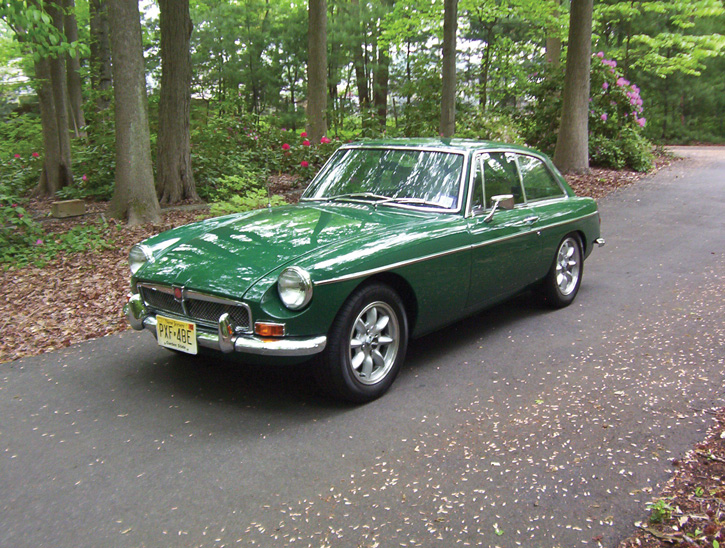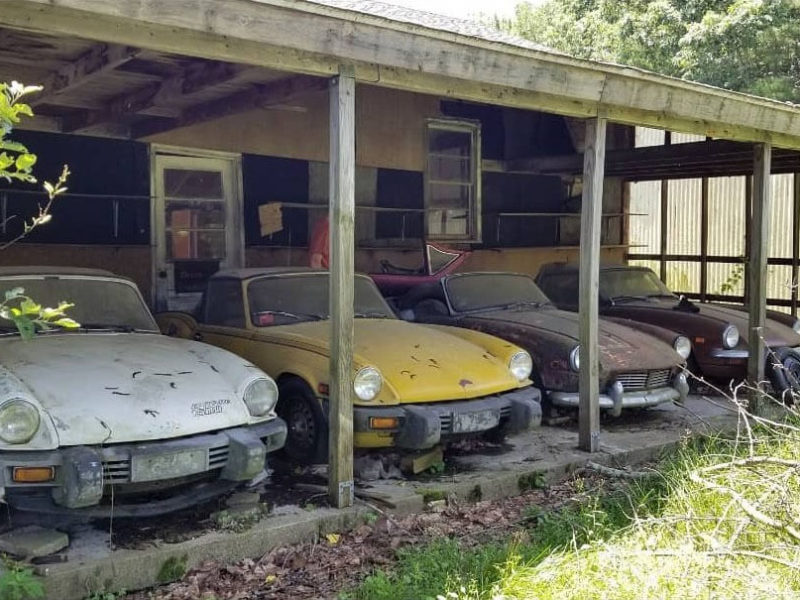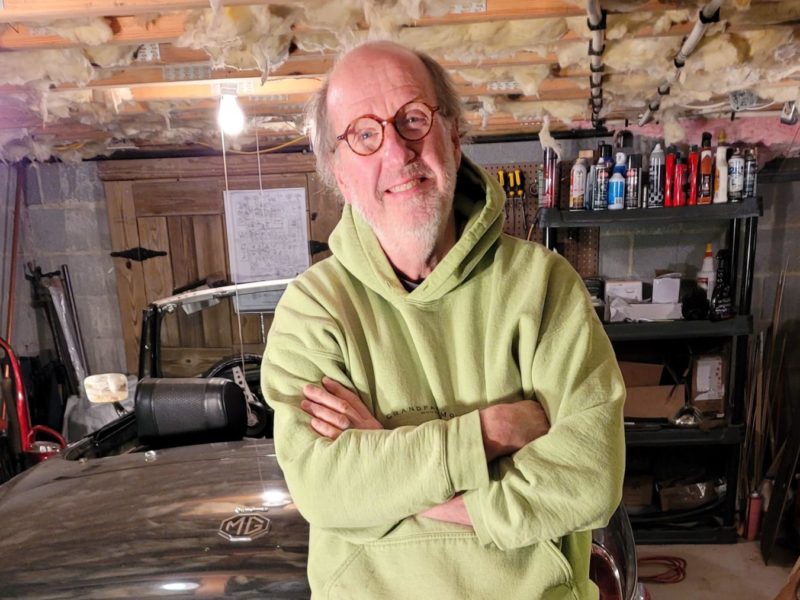Over the years I have restored several sports cars including a Lotus Elan and an Alfa Romeo spider, as well as a non-sports car, a Morris Minor Traveler. My daily drivers have been a series of 4 cylinder cars (with the exception of a 2 cylinder Honda 600). About 6 years ago I thought it was time to try a car with some torque, but not give up the responsiveness of a light car. My first choice was a Sunbeam Tiger, but the high prices and scarcity of parts was discouraging. I had always liked the looks of the chrome bumper MGB GT, and the concept of comfortable year round motoring that it promised. I also knew that it was possible to fit a V8 engine in an MGB, thus solving the torque problem.
 After looking for a while, I came across a 1968 GT body. It was a straight, rust free California body, that was missing the drive train, interior, most trim, dashboard, etc. In short, it was just what I was looking for! In deciding on the choice of engine, I realized that the Rover V8 and related engines were commonly used and well supported with technology and parts. But I wanted to try a Ford V8 because of its greater power potential and nearly equivalent weight. The Ford engine, with aluminum heads, tube headers, light flywheel, etc. weighs only about 60 pounds more that the MGB 4 cyl engine, and the matching Ford T-5 transmission is about 30 pounds lighter than the MGB unit.
After looking for a while, I came across a 1968 GT body. It was a straight, rust free California body, that was missing the drive train, interior, most trim, dashboard, etc. In short, it was just what I was looking for! In deciding on the choice of engine, I realized that the Rover V8 and related engines were commonly used and well supported with technology and parts. But I wanted to try a Ford V8 because of its greater power potential and nearly equivalent weight. The Ford engine, with aluminum heads, tube headers, light flywheel, etc. weighs only about 60 pounds more that the MGB 4 cyl engine, and the matching Ford T-5 transmission is about 30 pounds lighter than the MGB unit.
I did an internet search to find out if the Ford engine would fit, but there was little information. Many conversions put the engine far to the rear such that the heater shelf was cut out, and used hood scoops to clear the carburetor. But my goal was to produce a car with stock external appearance and as stock appearing an engine installation as possible. I finally bought a full size plastic Ford engine replica, and after test fitting it determined that I could keep the heater and clear the stock hood by careful choice of engine accessories such as the intake manifold, timing cover, water pump and alternator. I even found that Offenhauser was still making their original 60’s Ford valve covers and decided they would be a nice finishing touch.
 To get the project going I bought a MIG welder and sort of learned how to use it (I had never welded before). The first step was to reconfigure the engine compartment to 1977 standards using the standard front bulkhead, radiator supports, forward crosspiece, and front suspension cross member with 3.5 ratio steering rack. The modifications went reasonably well, and my welding is still holding up. (An angle grinder made my amateurish welds look much better.) The hardest part of the engine installation was making the exhaust headers. These I tack welded and had a professional welder finish off. When the body modifications were finished, I had the car painted, then began the assembly process. Unfortunately, it took two years to find a body shop that would paint an empty shell, and if I ever do this again, I might try to do the painting myself.
To get the project going I bought a MIG welder and sort of learned how to use it (I had never welded before). The first step was to reconfigure the engine compartment to 1977 standards using the standard front bulkhead, radiator supports, forward crosspiece, and front suspension cross member with 3.5 ratio steering rack. The modifications went reasonably well, and my welding is still holding up. (An angle grinder made my amateurish welds look much better.) The hardest part of the engine installation was making the exhaust headers. These I tack welded and had a professional welder finish off. When the body modifications were finished, I had the car painted, then began the assembly process. Unfortunately, it took two years to find a body shop that would paint an empty shell, and if I ever do this again, I might try to do the painting myself.
To get enough parts to complete the car, I got what I could from a rusted out 1974 ½ GT such as window glass and the stainless window trim, the wiring harness, body hardware, etc. From Moss I bought the rest of the trim pieces, a covering kit for a 1977 dashboard, a complete interior kit, and many minor parts. I made a custom wiring harness from the 1974 ½ harness and another old MG harness, which allowed the use of all electronic gauges. With everything installed, I built an exhaust system from various lengths of pipes, adapters and standard mufflers. Most of the fasteners on the engine and in the engine compartment are stainless steel and I polished all of the visible ones.
 Once the car was on the road, it was very enjoyable at first, but there were many areas that needed improvement. I was hoping the car would be a relaxing highway cruiser as well as an entertaining sports car. The basics of a cruiser were there in that the gearing allowed the engine to turn at only 2000 RPM at 70 mph in 5th gear. To support sporting pretensions, there was an independent rear suspension (from Hoyle Engineering in England), and the weight distribution was almost exactly 50/50 (1248 pounds front, 1206 pounds rear). However, the car was very noisy due to a combination of engine and road noise (wind noise was never too bad), the brakes were marginal, the cooling was marginal, and the cornering was unstable at the limit.
Once the car was on the road, it was very enjoyable at first, but there were many areas that needed improvement. I was hoping the car would be a relaxing highway cruiser as well as an entertaining sports car. The basics of a cruiser were there in that the gearing allowed the engine to turn at only 2000 RPM at 70 mph in 5th gear. To support sporting pretensions, there was an independent rear suspension (from Hoyle Engineering in England), and the weight distribution was almost exactly 50/50 (1248 pounds front, 1206 pounds rear). However, the car was very noisy due to a combination of engine and road noise (wind noise was never too bad), the brakes were marginal, the cooling was marginal, and the cornering was unstable at the limit.
Over the years, I converted to an all stainless dual exhaust system, each side with a main muffler and a resonator, upgraded the brakes, recalibrated the suspension with adjustable shocks and optimized front and rear sway bars, tracked down every squeak and rattle, put in a custom aluminum radiator, replaced the clutch with a lower effort unit, and replaced the seats with the new Moss classic seats. The seats were a great upgrade, and now the steering wheel is only used for steering the car, and not as a driver restraint device. My most recent improvement was to cover all of the hidden interior areas with DynaMat sound proofing products, which finally killed the noise problem. The worst part of the DynaMat installation was removing the glued in headliner, then replacing it again with a new kit. Extreme patience was needed in that the removal process could dent the roof, and one slip up during installation could have destroyed a $400 kit. However, all went well.
My experience with the MG is much like that with every car I have restored in that they all had some bugs upon completion. The only way to fix things is to drive the car and be prepared to tear it apart again as necessary. With a highly modified car like the MG V8, the debugging process is even more difficult as re-engineering is often needed. But it pays off in the end. I have driven my MG to British V8 events in Tennessee and Ohio, and I occasionally take 300 mile round trips to out of state car shows. So far the car has been reliable, never having broken down on the road. However, it almost overheated in the Baltimore harbor tunnel at 1 AM when I was returning from the Tennessee meet, and I did break an axle shaft, but that happened while turning into my driveway so it doesn’t count.
Now that the car is so well sorted out I am thinking of installing a stroker kit for a little more torque.
By Larry Shimp








'MGB V8 Restomod' have 2 comments
February 16, 2014 @ 4:13 pm Tom Pearson
Hi, I recently (October) acquired a 1957 100-6 that had a Chevy Corvette 327 Corvette engne (dyno of 375 HP) with a modified 200R4 automatic transmission from a guy who built it for his wife, who after her first drive was afraid of it (it really scoots!) Great conversion with the 327 an easy fit with lots of room under the hood. Three season car as there is no heater! Currently awaiting a weather break to get the new top fitted (Moss) but have a problem that the bits and pieces of the body for attaching the top frame are missing. Have to buy some side curtins too! Has a new Moss interior. I am a bit worried about the new Moss 48 spoke wire wheels and hub splines handling he HP availiable. Overall a nice job for a very attractive price. I wish I could post some pics of it.
Tom in Indy.
December 5, 2023 @ 4:23 pm Brian Yeates
would like to see pix of your exhaust system esp the headers and how they fit around the steering column. thanks